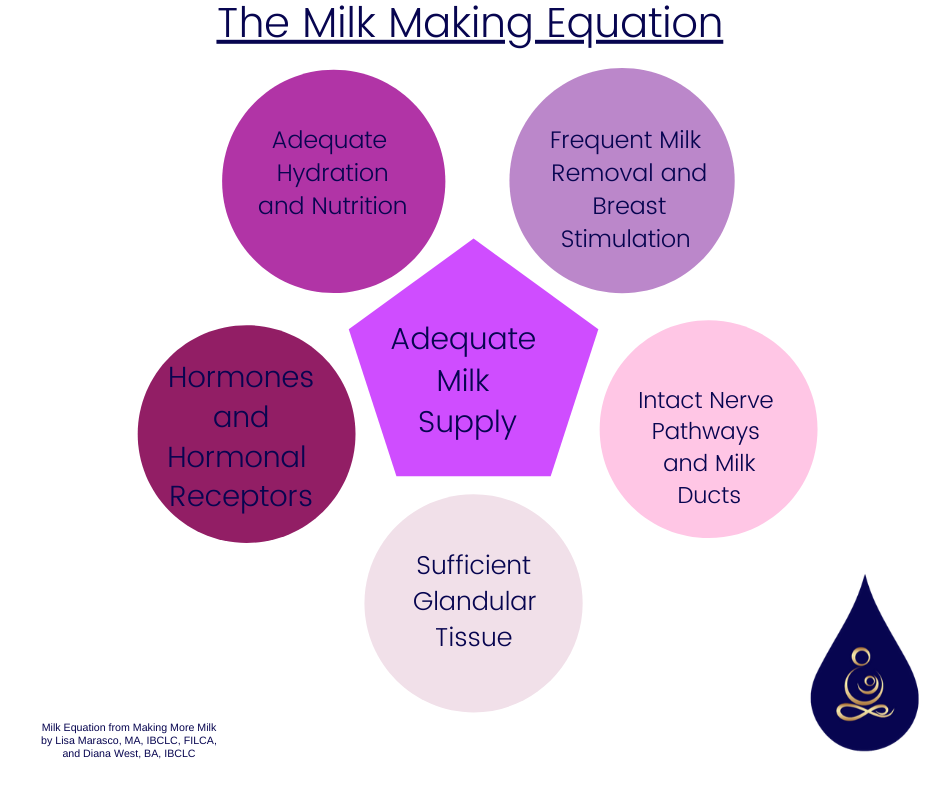
Learn all about Breastmilk Production
For the majority of breastfeeding parents, the process of making is not something they give a lot of thought to. The hormonally driven milk production process is easily maintained by adequate milk removal, and in the absence of any complicating factors easily moves along from the birth of the baby to weaning.
Only when a milk production issue arises do we need to consider all of the various factors that go into making enough breastmilk. If there is adeqaute glandular (milk making) tissue, no hormonal underlying issues, no damage to the nerves or milk ducts from accidents or previous surgeries, the breastfeeding parent is getting enough nutrition and hydration, and the breasts are properly stimulated by an effective latch or breast pump, milk production happens without much active effort.
Production of breastmilk goes through four easy to define and understand phases of lactogenesis (defined as the generation of milk).
Lactogenesis Stage 1
Lactogenesis Stage 1 begins at around the 16th week of pregnancy with the synthesis of colostrum.
Colostrum is the incredibly rich, nutritionally dense, first milk you will produce for your baby.
Colostrum is generally produced in small volume, and is designed to meet your baby’s needs in the first few days of life.
The thick viscosity of colostrum is perfect as your newborn is learning how to coordinate sucking in the first few days of life, and allows the baby to practice learning how to breastfeed without trying to manage the copious amounts of milk that are to come.
Lactogenesis Stage 2
Lactogenesis Stage 2 begins at the delivery of the placenta, and triggers the start of copious milk production.
There is a gradual increase in milk production through the first two weeks, with a noticeable increase typically around day 3 (referred to as your “milk coming in”).
This stage of lactogenesis is driven by hormones and even if no stimulation is occurring by nursing or pumping, will largely happen on its own.
If you have not noticed a substantial increase in milk production by 72 hours postpartum, you may be experiencing delayed lactogenesis, and this should be investigated by a lactation professional.
Lactogenesis Stage 3
Lactogenesis Stage 3 is defined by the maintenance of the milk supply, occurring around two weeks postpartum. Lactogenesis Stage 3 will continue as long as there is stimulation and milk removal.
The shift from hormonally controlled milk production to controlled by milk removal exclusively occurs around 12 weeks postpartum. This is a time referred to as supply regulation, where those who experienced a small oversupply in the beginning may find they reduce supply slightly to just what their baby needs.
The average milk supply at this stage in lactation is about 30 ounces per day.
If you initially experienced an adequate milk supply, but find after a few weeks you are struggling to make enough milk you need to see a lactation professional for a full assessment. This often indicates an issue with stimulation by a poor latch or poor breast flange fit, or lack of adequate milk removals.
Lactogenesis Stage 4
Lactogenesis Stage 4 is the end of lactation, and is marked by the involution of milk making tissue to its pre-pregnancy state.
This stage is regulated by reduced removal of milk, which allow the protein called “feedback inhibitor of lactation” to accumulate in the breast telling the body to stop producing milk.
Can my milk dry up suddenly?
This is a common fear for breastfeeding parents, and while many people have stories about their belief that their milk just dried up with no warning, this is incredibly uncommon. Here are the things that are actually going on that can be perceived as the milk supply drying up:
Growth spurt - During a growth spurt babies want to nurse more often, and can be grumpy, even refusing to sleep at night. If your baby is nursing frequently your breasts will be consistently drained, giving you the feeling that they are empty. This isn’t true though! Your breasts are never actually empty, as milk is synthesized when the baby elicits the letdown reflex. Soft breasts are still able to feed a baby.
Stress - stress inhibits the milk ejection reflex, which can make for a fussy baby who wants to nurse more often to try to meet their needs. Try to relax with your baby and things will go back to normal.
Poor breastfeeding management - it is really easy to get distracted during busy times, and to not nurse or pump as often as you should. If this goes on for some period of time you might experience a temporary drop in supply that could be addressed by increasing the frequency of emptying the breast.





